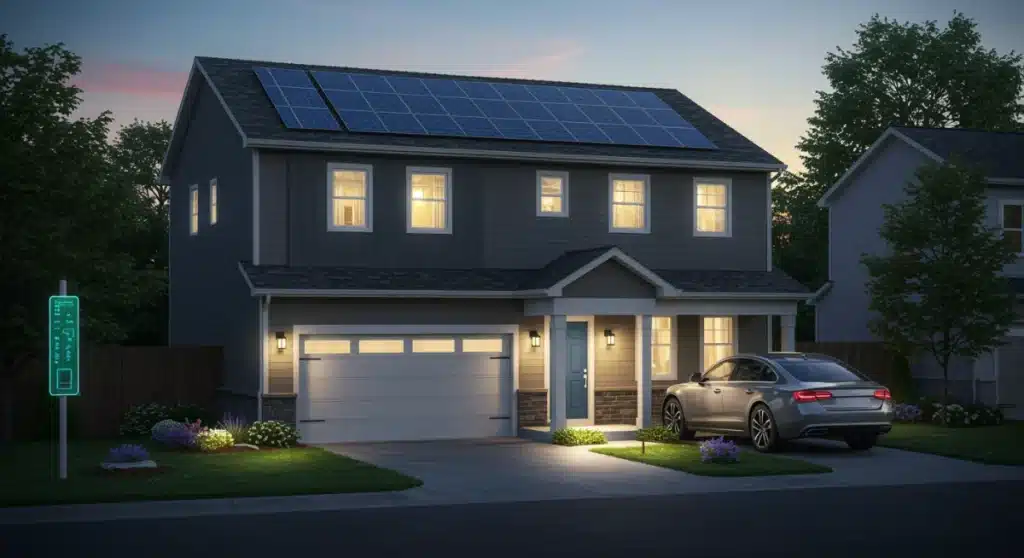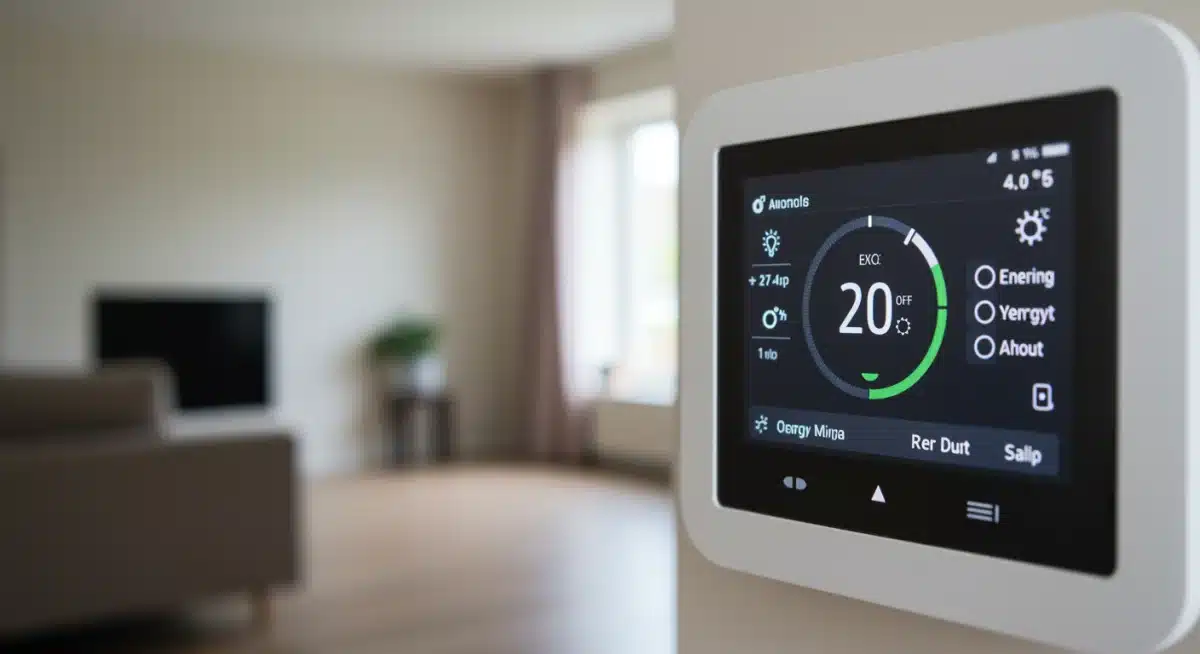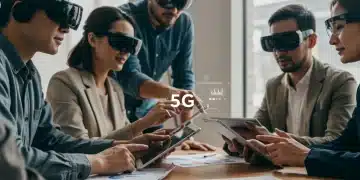Sustainable Tech Innovations: 4 Updates Saving US Homes 20% Energy

Recent sustainable tech innovations are enabling US households to achieve up to 20% energy savings this year, primarily through advancements in smart home devices, enhanced insulation, localized renewable energy, and ultra-efficient appliances.
The quest for a more sustainable future has never been more urgent, and thankfully, technology is stepping up to the challenge. In 2024, sustainable tech innovations are not just buzzwords but tangible solutions making a real difference in US households. These advancements are not only reducing our carbon footprint but also putting significant savings back into our pockets, with projections showing up to 20% energy savings for many families this year. This article delves into four key areas where cutting-edge technology is transforming how we consume and conserve energy at home, illustrating a clear path towards a more efficient and eco-friendly lifestyle.
The Rise of Smart Home Energy Management Systems
Smart home technology has evolved beyond mere convenience; it’s now a cornerstone of energy efficiency. These integrated systems offer unprecedented control and insight into household energy consumption, allowing homeowners to optimize usage in real-time. The ability to monitor, manage, and automate various appliances and environmental controls leads to significant reductions in wasted energy.
The core of smart home energy management lies in its interconnected devices. These devices communicate with each other and with central hubs, often controlled via smartphone apps or voice commands. This seamless integration ensures that energy is used only when and where it’s needed, adapting to household routines and external conditions.
Advanced Smart Thermostats
Modern smart thermostats do more than just adjust temperature. They learn household habits, integrate with weather forecasts, and can even detect occupancy to ensure optimal heating and cooling. This proactive approach prevents energy waste by not conditioning empty rooms or overworking HVAC systems.
- Learning Algorithms: These thermostats adapt to your schedule, automatically adjusting temperatures to save energy when you’re away.
- Zone Control: Many systems allow for individual temperature control in different areas of the home, preventing the need to heat or cool unused spaces.
- Remote Access: Adjust settings from anywhere, ensuring your home is comfortable only when you need it to be.
Intelligent Lighting Solutions
Smart lighting systems offer granular control over illumination, moving beyond simple on/off switches. They integrate motion sensors, daylight harvesting, and scheduling features to minimize electricity use without sacrificing comfort or visibility.
These systems can dim lights based on natural light levels or turn them off automatically in unoccupied rooms. The shift to LED technology, combined with smart controls, amplifies energy savings considerably. Homeowners can program complex lighting scenes that cater to different activities, further optimizing energy use.
In essence, smart home energy management systems empower homeowners to take an active role in their energy consumption. By providing detailed data and automation capabilities, these systems transform a home into an intelligent, energy-saving entity, contributing significantly to the 20% target.
Breakthroughs in Building Materials and Insulation
While often overlooked, the physical structure of a home plays a critical role in its energy efficiency. Recent innovations in building materials and insulation technologies are making homes more resilient to temperature fluctuations, drastically reducing the demand on heating and cooling systems. These advancements are foundational to achieving substantial energy savings in residential properties across the US.
Traditional insulation methods, while effective, are continuously being improved upon. The new generation of materials offers superior thermal resistance, greater durability, and often, more environmentally friendly compositions. This translates into less energy leakage and a more stable indoor climate, regardless of external weather conditions.
Aero-Gel Insulation
Derived from aerogel, a synthetic porous ultralight material, this insulation offers exceptional thermal performance. Originally developed for aerospace applications, its commercial viability for residential use is growing, offering superior R-values in thinner applications compared to conventional materials.
- High R-Value: Provides significantly better insulation per inch, allowing for more effective thermal barriers in smaller spaces.
- Lightweight and Durable: Despite its ethereal appearance, aerogel insulation is robust and long-lasting.
- Versatile Application: Can be used in walls, roofs, and even windows, enhancing overall building envelope performance.
Advanced Window Technologies
Windows are notorious for heat loss and gain. New window technologies, including triple-pane glass, low-emissivity (low-e) coatings, and gas fills (like argon or krypton), are dramatically improving their insulating properties. These innovations prevent heat from escaping in winter and entering in summer.
Smart windows that can dynamically adjust their tint based on sunlight intensity are also emerging, offering passive solar control. This reduces the need for air conditioning and artificial lighting, contributing to both energy savings and indoor comfort. The integration of these window technologies into new constructions and renovations is pivotal for enhanced energy performance.

The synergy between advanced insulation and window technologies creates a highly efficient building envelope. By minimizing thermal transfer, these innovations ensure that a home’s internal temperature is maintained with minimal energy input, becoming a silent but powerful contributor to the 20% energy savings goal.
Decentralized Renewable Energy Solutions for Homes
The shift towards renewable energy sources is accelerating, and increasingly, this transition is happening at the household level. Decentralized renewable energy solutions, primarily solar and increasingly wind, are empowering US homeowners to generate their own clean electricity, reducing reliance on the grid and lowering utility bills. This direct generation of energy is a game-changer for achieving significant, long-term energy savings.
These solutions offer not just environmental benefits but also economic ones. With improved efficiency and decreasing costs, residential renewable energy systems are becoming more accessible and attractive. They provide a hedge against rising electricity prices and contribute to a more resilient energy infrastructure.
Residential Solar Power Systems
Solar photovoltaic (PV) systems are the most common form of home-based renewable energy. Advances in solar panel efficiency, energy storage, and inverter technology have made these systems more powerful and cost-effective than ever before.
- High-Efficiency Panels: Modern panels convert more sunlight into electricity, even in less-than-ideal conditions, maximizing energy generation from available roof space.
- Battery Storage: Integrated battery systems store excess solar energy for use during peak demand hours or at night, further reducing grid dependency.
- Microinverters: These optimize power output from individual panels, improving overall system performance and reliability.
Small-Scale Wind Turbines for Urban/Suburban Use
While less common than solar, small-scale wind turbines are gaining traction in areas with consistent wind patterns. Innovations in turbine design have led to quieter, more aesthetically pleasing, and more efficient models suitable for residential applications.
These turbines can complement solar installations, providing a more consistent energy supply, especially in regions where solar output fluctuates seasonally. The combination of solar and wind can create a highly resilient and self-sufficient energy system for a home, pushing towards net-zero energy consumption.
Embracing decentralized renewable energy solutions transforms homeowners into energy producers, not just consumers. This fundamental shift not only contributes directly to the 20% energy savings target but also fosters a greater sense of energy independence and environmental stewardship.
Innovations in Energy-Efficient Appliances
Appliances are significant energy consumers in any household. Fortunately, manufacturers are continually pushing the boundaries of efficiency, integrating smart technologies and advanced engineering to drastically reduce the energy footprint of everyday devices. These innovations mean that replacing older appliances with newer, more efficient models can yield substantial energy savings.
The evolution of energy-efficient appliances goes beyond simply meeting minimum regulatory standards. It involves rethinking how these devices operate, optimizing their performance, and minimizing their standby power consumption. This holistic approach ensures that every watt is used as effectively as possible.
Heat Pump Technology for HVAC and Water Heating
Heat pumps are a cornerstone of modern energy efficiency, providing both heating and cooling, and even hot water, with remarkable efficiency. Unlike traditional furnaces or water heaters that generate heat, heat pumps move heat from one place to another, a far more energy-efficient process.
- Air Source Heat Pumps: Extract heat from the air (or reject it into the air for cooling), offering significant savings over conventional HVAC systems.
- Geothermal Heat Pumps: Utilize the stable temperature of the earth to provide highly efficient heating and cooling, often resulting in the lowest operating costs.
- Heat Pump Water Heaters: Use ambient air to heat water, consuming a fraction of the electricity of standard electric water heaters.
Advanced Refrigeration and Laundry Appliances
Refrigerators and washing machines have seen considerable efficiency gains. Modern refrigerators feature improved insulation, more efficient compressors, and smart defrost cycles that minimize energy use. Washing machines now use less water and energy through advanced wash cycles and sensor technology.

These appliances often come with Energy Star ratings, indicating their superior efficiency. Choosing these models represents a straightforward yet powerful way for households to reduce their energy consumption. The cumulative effect of upgrading multiple appliances can significantly contribute to the overall 20% energy savings target.
The continuous innovation in energy-efficient appliances demonstrates a clear commitment from manufacturers to sustainable practices. By integrating these advanced devices into our homes, we can enjoy modern conveniences with a much lighter environmental and financial footprint.
Policy, Incentives, and the Future of Home Energy Savings
While technological advancements are crucial, governmental policies and financial incentives play an equally vital role in accelerating the adoption of sustainable tech innovations. In the US, a combination of federal, state, and local programs is designed to make energy-efficient upgrades more accessible and affordable for households. These frameworks are essential for democratizing access to technologies that drive significant energy savings.
Understanding the available incentives can dramatically reduce the upfront cost of implementing sustainable solutions, making the 20% energy savings goal more attainable for a broader segment of the population. These policies are not just about environmental protection; they are also about economic stimulus and job creation in the green sector.
Federal Tax Credits and Rebates
The US government offers various tax credits for homeowners who invest in renewable energy systems and energy-efficient home improvements. These credits can offset a significant portion of the installation costs, making projects like solar panel installation or heat pump upgrades more financially viable.
- Residential Clean Energy Credit: Offers a tax credit for new, qualified clean energy property for your home, including solar, wind, and geothermal systems.
- Energy Efficient Home Improvement Credit: Provides tax credits for certain energy-efficient home improvements, such as insulation, efficient windows, and heat pumps.
State and Local Programs
Beyond federal incentives, many states and local municipalities offer their own programs, including rebates, grants, and low-interest loans for energy efficiency and renewable energy projects. These programs are often tailored to regional needs and can provide additional layers of financial support.
Utilities also frequently offer incentives for customers to upgrade to more efficient appliances or participate in demand-response programs. Staying informed about these local opportunities is key to maximizing savings when investing in sustainable tech.
The future of home energy savings is bright, driven by ongoing innovation and supportive policies. As these technologies become more integrated and incentives more pervasive, achieving and even surpassing the 20% energy savings target will become the new standard for US households. This collaborative effort between technology, policy, and consumer adoption is creating a truly sustainable and economically viable energy landscape for our homes.
Overcoming Barriers to Adoption and Maximizing Impact
Despite the clear benefits and burgeoning availability of sustainable tech innovations, widespread adoption still faces several hurdles. Understanding these challenges and strategizing to overcome them is crucial for maximizing the impact of these technologies on US household energy savings. Education, accessibility, and integrated solutions are key to bridging the gap between potential and widespread reality.
The complexity of choosing the right technologies, the initial investment costs, and sometimes a lack of awareness can deter homeowners. Addressing these issues systematically will ensure that more households can partake in the energy revolution and contribute to the collective goal of sustainability.
Addressing Upfront Costs and Financing Options
The initial investment for many sustainable tech solutions, such as solar panels or advanced insulation, can be substantial. While incentives help, comprehensive financing options are essential. Programs like Property Assessed Clean Energy (PACE) loans, green mortgages, and energy-specific loan products can make these upgrades more affordable.
Furthermore, demonstrating the long-term return on investment (ROI) through clear, accessible data can convince homeowners that the upfront cost is a worthwhile investment. Highlighting reduced utility bills and increased property value are powerful motivators.
Enhancing Consumer Education and Awareness
Many homeowners are simply unaware of the full spectrum of sustainable tech innovations available or how to best implement them. Educational campaigns from government agencies, non-profits, and industry associations can play a vital role in informing the public.
- Workshops and Webinars: Providing accessible information on various technologies and their benefits.
- Online Resources: Creating user-friendly platforms that guide homeowners through the process of selecting, financing, and installing sustainable solutions.
- Case Studies: Showcasing successful implementations and the tangible savings achieved by other households.
Promoting Integrated and Holistic Solutions
Often, homeowners adopt sustainable technologies in isolation, missing out on the synergistic benefits of integrated systems. Encouraging a holistic approach, where smart home management, efficient building envelopes, and renewable energy generation work in concert, can yield far greater savings.
For example, a home with excellent insulation and efficient appliances will get more mileage out of a smaller solar array. Promoting whole-house energy audits and integrated solution packages can simplify decision-making and maximize overall efficiency gains for US households.
Overcoming these barriers requires a concerted effort from all stakeholders – policymakers, technology providers, and consumers. By making sustainable tech innovations more accessible, understandable, and affordable, we can accelerate their adoption and ensure that the promise of 20% energy savings and a greener future becomes a reality for every American home.
| Key Innovation | Impact on Energy Savings |
|---|---|
| Smart Home Energy Systems | Optimizes energy use through automation and real-time monitoring, reducing waste from HVAC and lighting. |
| Advanced Insulation & Materials | Enhances thermal envelope, significantly cutting heating and cooling loads on HVAC systems. |
| Decentralized Renewables | Allows homes to generate their own clean electricity, reducing grid reliance and utility bills. |
| Energy-Efficient Appliances | Reduces energy consumption of daily-use devices like refrigerators, washers, and heat pumps. |
Frequently Asked Questions About Sustainable Tech Innovations
The primary benefits include significant reductions in monthly energy bills, a smaller carbon footprint, increased home comfort through better temperature regulation, and often an increase in property value. These technologies contribute to a more resilient and independent energy future for households.
US households can realistically achieve up to 20% or more in energy savings this year by strategically implementing a combination of these sustainable tech innovations. Actual savings depend on the starting efficiency of the home and the scope of upgrades made.
Yes, both federal and state governments offer various incentives, including tax credits and rebates, for homeowners investing in renewable energy systems, energy-efficient appliances, and home improvements like advanced insulation. These programs aim to make upgrades more affordable.
Smart home systems play a crucial role by providing real-time data on energy consumption, automating appliance usage, and optimizing heating and cooling based on occupancy and external conditions. This intelligent management minimizes waste and maximizes efficiency.
Advanced building materials and insulation, such as aerogel and low-e windows, significantly improve a home’s thermal envelope. They reduce heat transfer, meaning less energy is required to maintain comfortable indoor temperatures throughout the year, cutting HVAC costs.
Conclusion
The landscape of home energy consumption is undergoing a profound transformation, driven by a wave of sustainable tech innovations. From intelligent smart home systems that learn our habits to advanced building materials that seal our homes against the elements, and from decentralized renewable energy solutions that empower us to generate our own power to ultra-efficient appliances that redefine performance, the path to significant energy savings is clearer than ever. US households are now equipped with the tools to achieve up to 20% energy savings this year, marking a pivotal moment in our collective journey towards a more sustainable and economically sound future. Embracing these technologies not only benefits our wallets but also strengthens our commitment to a healthier planet for generations to come.





